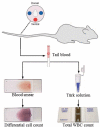A minimally invasive, low-stress method for serial blood collection in aging mice
- PMID: 31489140
- PMCID: PMC6711170
- DOI: 10.1080/20010001.2019.1647400
A minimally invasive, low-stress method for serial blood collection in aging mice
Abstract
Hematologic analysis is an efficient and valuable tool for real-time health monitoring and immune analysis in mouse aging studies. However, many frequently used blood sampling techniques in mice are incompatible with continuous monitoring with increasing age, as they may involve anesthesia, cause severe stress, or require a high volume of blood. This technical report describes a convenient relatively noninvasive procedure for counting white blood cells in C57Bl/6 mice by an optimized tail blood collection method followed by Wright-Giemsa and Türk staining. This technique can be performed on unanesthetized mice in less than 1 min with minimal stress using only a few microliters of blood. White blood cell analysis can include but is not limited to total and differential white blood cell count and cell morphology. The low blood volume collected is ideal for aging mice in longer-term experiments requiring regular and continuous monitoring.
Keywords: Blood collection protocol; aging mice; hematology; white blood cell differentiation.
Figures



References
-
- Schwab CL, Fan R., Zheng Q., et al. Modeling and predicting stress-induced immunosuppression in mice using blood parameters. Toxicol Sci. 2005;83:101–4. - PubMed
-
- Fulop T, Franceschi C, Hirokawa K, et al. Immunosenescence. Houten (Nederland): Springer International Publishing; 2009.
-
- Tsai PP, Schlichtig A, Ziegler E, et al. Effects of different blood collection methods on indicators of welfare in mice. Lab Anim. 2015;44:301–310. - PubMed
Grants and funding
LinkOut - more resources
Full Text Sources
